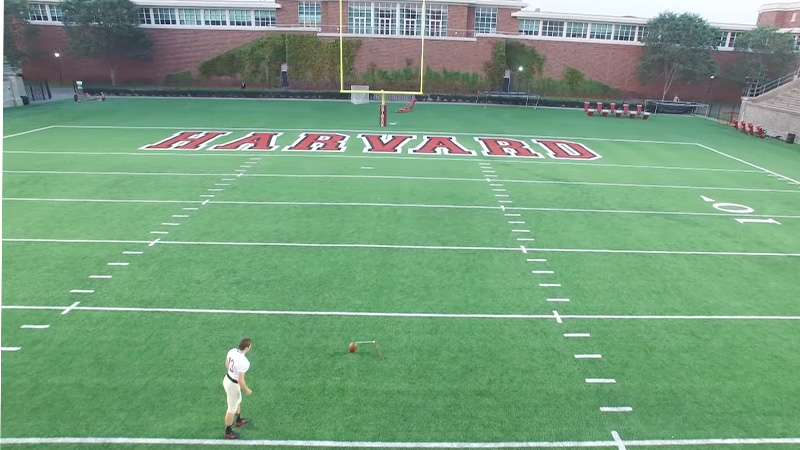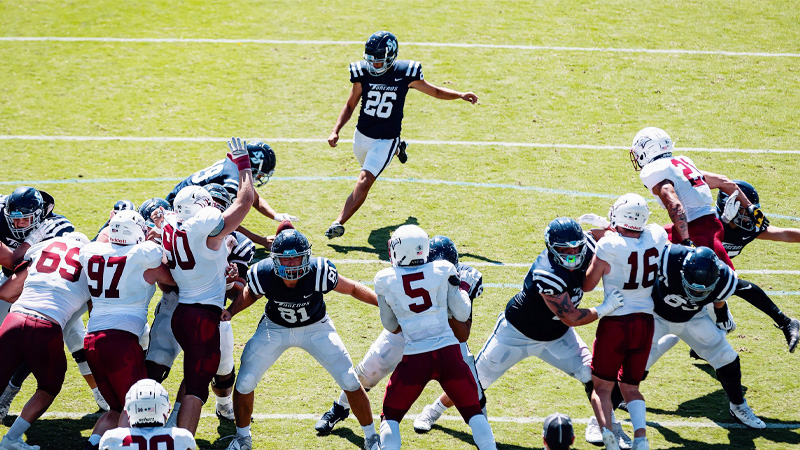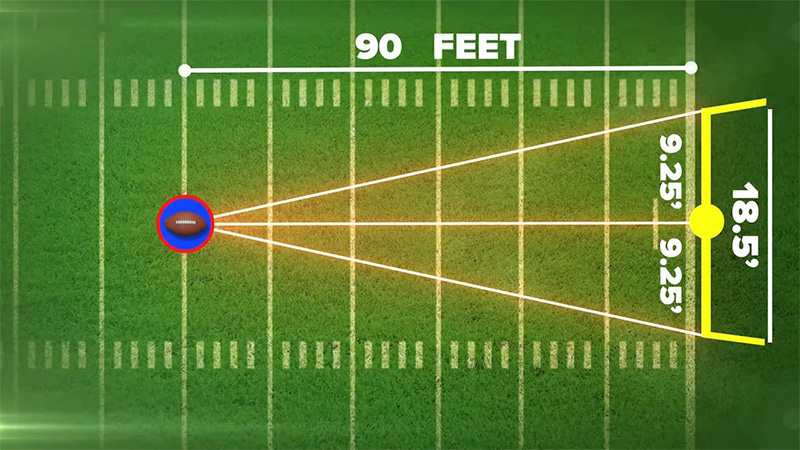In the world of American football, field goals play a pivotal role in determining the outcome of games. These precise kicks can swing momentum, secure victories, or even rewrite history in the sport.
But have you ever wondered how the distance of a field goal is determined? In this post, we delve into the fascinating world of field goal measurements in football.
Field goals are more than just opportunities to score points; they are strategic decisions based on the distance from the goalposts to the line of scrimmage. This distance, measured in yards, directly affects the level of difficulty for the kicker.
How are field goals measured in football is crucial for appreciating the strategy behind each attempt and the remarkable skill required to succeed.
Join us as we uncover the intricacies of field goal measurements, explore rule variations, and gain insights into the factors that make this aspect of football both challenging and thrilling. Stay focused.
What Is A Field Goal?
In American football, a field goal is a scoring play that occurs when a team kicks the football through the opponent’s goalposts, located at the back of the end zone.
Field goals are typically attempted on fourth down when a team is within kicking range of the goalposts but unable to advance the ball for a touchdown.
To execute a field goal, a special teams player known as the kicker takes a snap from the center and attempts to kick the ball through the uprights, which are the two vertical posts connected by a horizontal crossbar.
If the ball successfully travels through the uprights, the team is awarded three points. The distance and angle of the kick can vary, with longer kicks requiring greater accuracy and leg strength.
Field goals are an essential component of scoring in American football and can be a critical strategy for teams looking to secure points when they can’t reach the end zone.
How Are Field Goals Measured In Football
In American football, field goals are measured in yards from the line of scrimmage to the location of the goalposts. Here’s how it works:
Line of Scrimmage
The line of scrimmage is the imaginary line on the field where the play begins. The offense sets up behind this line, and the defense lines up opposite them.
The distance from the line of scrimmage to the goalposts is what determines the length of the field goal attempt.
Yardage
The yardage is usually described as the distance from the line of scrimmage to the goalposts.
For example, if a field goal attempt is made from the 20-yard line, it means the ball is snapped from the 20-yard line, and the goalposts are 10 yards beyond the end zone, making the total distance 30 yards.
Goalpost Placement
In the NFL and many other levels of American football, the goalposts are situated at the back of the end zone, and they are 18 feet, 6 inches apart.
Measuring Success
A successful field goal occurs when the kicker successfully kicks the ball through the uprights and between the goalposts. The number of points awarded is determined by the distance of the attempt.
For instance, a field goal attempt from the 20-yard line (a total of 30 yards) is worth three points, while a longer attempt, such as from the 40-yard line (a total of 50 yards), is also worth three points if successful.
So, the measurement of field goals in football is based on the distance in yards from the line of scrimmage to the goalposts, with the success of the kick determining the number of points awarded.
Factors Influencing Field Goal Accuracy

Field goal accuracy in American football is influenced by several key factors, which collectively determine whether a kicker successfully makes the kick through the goalposts.
Here are some significant factors that can affect field goal accuracy:
Distance and Angle
The distance from the line of scrimmage to the goalposts and the angle at which the kicker approaches the kick are fundamental factors.
Longer kicks and kicks from acute angles require greater precision and leg strength. Kickers must calculate these factors to adjust their approach and aim accurately.
Kicker’s Technique
A kicker’s technique encompasses several aspects, including leg swing, follow-through, and foot placement. Proper form and consistency are crucial for accuracy.
Any deviation in their mechanics can result in the ball being misdirected or falling short.
Weather Conditions
Weather can be a significant variable. Wind, in particular, can affect the trajectory of the ball. Kickers must gauge wind direction and intensity to compensate accordingly.
Rain or snow can also impact the grip and condition of the football, making it harder to strike cleanly.
Holder and Snapper Quality
The holder and snapper are unsung heroes in field goal attempts. A poor snap or a mishandled hold can disrupt the kicker’s rhythm and timing, leading to inaccurate kicks.
A consistent and reliable operation between these players is crucial for success.
Field Surface
The playing surface, whether grass or artificial turf, can affect a kicker’s footing.
A well-maintained field provides stable footing, whereas a muddy or uneven surface can lead to slips and mishits. Kickers often adjust their plant foot to accommodate the surface.
Psychological Factors
The mental state of the kicker is a significant factor. Confidence, focus, and the ability to handle pressure can make or break a field goal attempt.
Kickers must maintain composure in high-stakes situations, blocking out distractions and self-doubt.
Fatigue and Timing
Kicking is physically demanding, and a tired leg can impact accuracy. Coaches must manage a kicker’s workload throughout a game or season to ensure they have the necessary strength and timing when it matters most.
Field goal accuracy is the result of a delicate interplay between physical and mental factors.
Kickers must possess the technical skill and adaptability to handle varying conditions while maintaining their mental composure.
Rule Changes and Innovations REgarding Field Goals

The rules and innovations regarding field goals in American football have evolved over the years to enhance the fairness and safety of the game.
While many fundamental aspects of field goal attempts remain consistent, there have been some notable rule changes and innovations:
Narrowing the Goalposts (1967)
In 1967, the NFL narrowed the width of the goalposts from 18 feet to the current standard of 10 feet. This change increased the difficulty of making field goals, leading to a greater emphasis on kicker accuracy.
Tee Usage (1989)
Up until 1989, kickers were allowed to use a kicking tee for field goals and extra points.
The NFL eliminated the use of tees for these kicks, requiring kickers to kick the ball directly off the ground, which made the kicks more challenging.
Two-Point Conversion (1994)
The introduction of the two-point conversion in 1994 provided teams with an alternative to attempting field goals after touchdowns.
Teams can choose to try for two points by running or passing the ball into the end zone, which adds a strategic element to scoring.
Kickoff Location (2011)
In 2011, the NFL moved the kickoff location from the 30-yard line to the 35-yard line.
This change resulted in more touchbacks and, subsequently, fewer kickoff return attempts, affecting field position for both offensive and defensive strategies.
Extra Point Distance (2015)
The NFL moved the line of scrimmage for extra point attempts from the 2-yard line to the 15-yard line in 2015.
This made extra point attempts more challenging and less automatic, adding excitement to point-after-touchdown situations.
Automatic Review (2019)
Beginning in 2019, all scoring plays, including field goals, are subject to automatic review by officials. This ensures the accuracy of field goal attempts, especially in close or game-deciding situations.
Practice Methods and Technology
Kickers and special teams coaches have embraced innovations in training and technology, such as virtual reality simulations and advanced analytics, to improve kicking accuracy and decision-making.
Innovations in Kicking Equipment
Advancements in kicking shoe design and football construction have aimed to optimize ball flight and enhance a kicker’s ability to make accurate field goals.
These rule changes and innovations have influenced the dynamics of field goals in American football, making them more challenging and strategic.
Additionally, they have contributed to the overall excitement and competitiveness of the game by introducing new elements and emphasizing the importance of special teams in a team’s success.
Factors Affecting Field Goal Success

Field goal success in American football is influenced by a variety of factors that impact the accuracy and effectiveness of a field goal attempt. Here are the key factors that can affect field goal success:
Distance
The distance from the line of scrimmage to the goalposts plays a significant role. Longer field goal attempts require more power and accuracy from the kicker, making them inherently more challenging.
Kicker’s Skill
The skill and technique of the kicker are crucial. Experienced and highly skilled kickers tend to have better accuracy. Their approach, leg swing, and follow-through all contribute to their success.
Snap and Hold
A precise snap from the long snapper and a stable hold from the holder is essential for a successful field goal attempt. Any mishandling of the snap or hold can disrupt the timing and accuracy of the kick.
Wind Conditions
Wind speed and direction can affect the flight of the football. Kickers must adjust their aim and power based on the wind conditions. Windy conditions can make it difficult to predict the ball’s path.
Field Conditions
The condition of the playing surface can affect a kicker’s stability and approach. A muddy or uneven field may lead to less consistent kicks.
Pressure Situations
High-pressure situations, such as game-winning or game-tying field goal attempts, can affect a kicker’s mental state and focus. Confidence and composure are critical in these situations.
Temperature and Altitude
Extreme temperatures and high-altitude stadiums can impact the flight of the football due to changes in air density. Kicks may behave differently in these conditions.
Goalpost Width
In different levels of play (e.g., NFL, college, high school), the width of the goalposts can vary. Narrower goalposts require higher accuracy to successfully make a field goal.
Time Constraints
In some situations, such as the play clock running down, kickers may need to rush their kicks, which can lead to reduced accuracy.
Blocking Attempts
Defensive players may attempt to block a field goal by jumping or reaching for the ball. This can add pressure on the kicker to get the ball over the defenders while maintaining accuracy.
Timeouts and Distractions
Opposing teams may attempt to ice the kicker by calling timeouts just before the kick. Noise and distractions from the crowd can also affect a kicker’s concentration.
Holder’s Placement
The holder’s placement of the ball can impact the angle at which the kicker approaches the ball. A precise placement is crucial for accuracy.
Kicking Foot
Whether the kicker is right-footed or left-footed can affect the angle at which the ball is kicked, which can impact accuracy, especially on longer kicks.
Team’s Strategy
The team’s overall strategy, such as whether they choose to attempt a field goal or go for it on fourth down, can influence field goal attempts.
FAQs
How is the distance of a field goal measured in football?
The distance of a field goal in football is measured from the line of scrimmage to the location of the goalposts. This yardage determines the length of the field goal attempt, with the goalposts situated 10 yards beyond the end zone.
Can field goals be attempted from any distance on the field?
Yes, field goals can be attempted from various distances on the field, depending on a team’s position. The line of scrimmage for the kick determines the distance, with longer attempts requiring greater leg strength and accuracy.
How many points is a successful field goal worth?
A successful field goal in football is typically worth three points. However, the number of points awarded can vary based on the specific league or rule variations in different levels of play.
Do field goals count if they hit the goalposts and bounce through?
Yes, if a field goal attempt hits the goalposts (either the uprights or the crossbar) and then goes through, it is considered a successful field goal, and the kicking team is awarded the appropriate number of points.
Are field goals measured differently in college football compared to the NFL?
Yes, field goals are measured differently in college football and the NFL.
While the goalposts are in the same position, the width between the uprights in the NFL is narrower, making field goals more challenging, especially for accuracy.
Wrapping Up
Field goals are the embodiment of precision and skill in American football. As we’ve explored the measurement process behind these critical plays, it becomes evident that they are more than just simple kicks.
In fact, they are calculated decisions with the potential to shape the outcome of games.
Whether it’s the distance, the wind, or the pressure of the moment, field goals represent the culmination of various factors converging on the kicker’s leg.
So, the next time you watch a football game and witness a field goal attempt, you’ll have a deeper appreciation for the science and strategy involved.
It’s in these moments that the sport’s essence truly shines—a blend of strategy, athleticism, and unyielding determination to put points on the board. Thank you so much.







